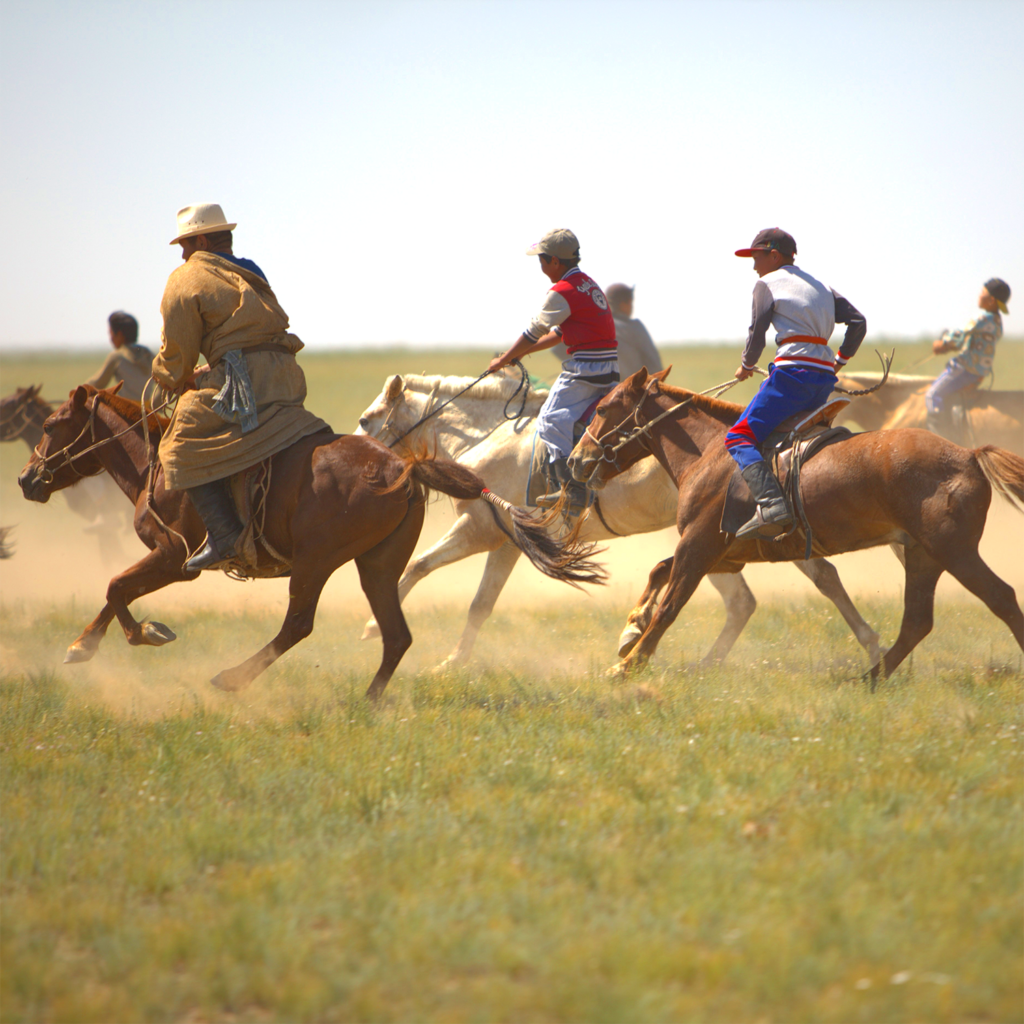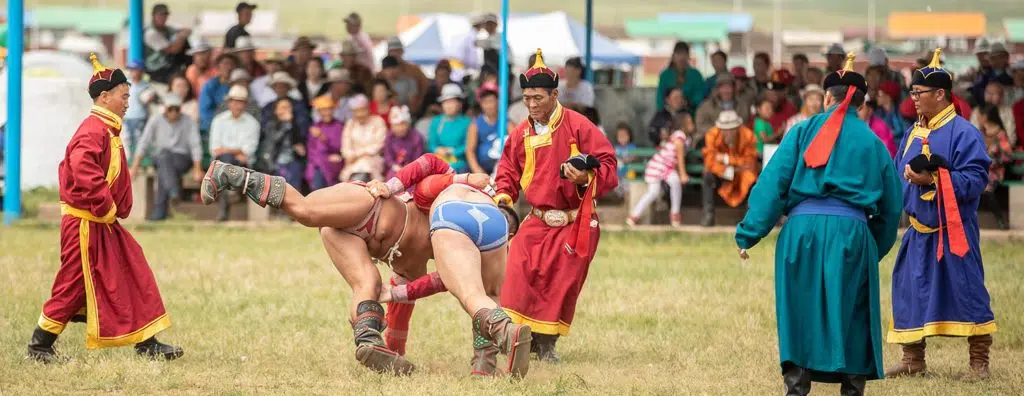Mongolia’s Centuries-Old Festival of Competition
Festivals are more than just a celebration; they are a way to honor one’s traditions and history. However, some festivals are woven into the identity of a place. Holi in India. Dia de Los Muertos in Mexico. And, Naadam in Mongolia. Held annually in the summertime, Naadam is celebrated across the country, from the capital city of Ulaanbaatar to the remote towns of the Gobi.

The History of Naadam
Naadam dates back to the Hunnu empire (Xiongnu). It was originally designed as a way to keep soldiers in shape during peacetime and boost morale. Mongolia’s strong warrior mindset is woven into the national identity, and over the years, Naadam’s importance in the collective cultural identity grew. Of course, during Communist rule, anything representing tradition, history, and cultural significance came under fire and Naadam’s future would have been uncertain if not for the quick thinking of the Mongol leader, Choibalsan (1939-1952). He suggested Stalin organize Naadam, not as a way to celebrate Mongolian nationality but to celebrate the independence day of 1921. He gave his permission and Naadam has thrived ever since.
A Summer Celebration
The national Naadam, held in Ulaanbaatar, is anxiously anticipated each year and takes place for two days every July 11th and 12th. It hosts the highest number of competitors and attracts the largest amount of tourists. Meanwhile, in the countryside, Naadam is celebrated throughout the summer in every province and local village. While these smaller events have fewer competitors, visitors are rewarded with better access to the competitions.
The Spirit of Competition
So what really happens during Naadam? The name itself translates to “the three manly games,” and at its core, Naadam is a competition. The three games are wrestling, horse racing, and archery—all activities that Mongols pride themselves on. Pride is indeed a part of this festival, as women are no longer permitted to compete in wrestling after one woman summarily beat all the men in the competition. Never one to lose face, the men ensured that no woman would ever beat them again by banning their participation with a wardrobe alteration. All wrestling uniforms have a bare chest—effectively banning women—however, women do compete in the horse racing and archery competitions.

Ulaanbaatar, Mongolia: A referee checking two young wrestlers inside the National Sports Stadium at the Naadam Festival wrestling competition
Wrestling
Mongolian wrestling Is rooted in hand to hand combat, and over time moves transitioned from battle to sport. There are five different styles of wrestling in Mongolia, with the most popular and widely practiced style being Khalkha wrestling. Buryad wrestling is practiced in the southern part of Siberia amongst the Buryad ethnic group; Oirad wrestling is practiced in the western part of Mongolia, and Kuresh wrestling is practiced amongst the Tuvan people in southern Siberia. Khorchin wrestling is practiced by the Inner Mongolians and the distinguishing factor is that the Khorchin wrestler wears a jacket made from cow leather and long pants.
During the national Naadam wrestling competition, there are 1,072 wrestlers vying for the grand title of National Grand Champion. Rankings begin at the bottom with falcon, and move up the ladder to hawk, elephant, garuda, lion, national champion, surge champion, wide champion, and finally, national grand champion.
It is said that there are up to 666 tricks to bring an opponent down, but in Mongolia, there are no age limits, no time limits, and certainly no size limits in competition. It is not uncommon to see a David and Goliath-style match, often with the smaller guy winning.

Archery
Archery is another Mongolian tradition, and during Naadam, there are three different types of archery: Khalkh, Buryad, and Uriankhai. All three are distinct ethnic groups in Mongolia, and the difference between each style is the types of bows and arrows used, as well as the distances of the targets. In Khalkha archery, women shoot targets at a distance of 60 meters, while men shoot at a distance of 75 meters. The targets are defined by little round balls that have been made by a long string of leather netted into a ball. Both Khalka and Buryad allow women to participate, but only men are permitted in Uriankhai archery.

Horse Racing
Horse racing is enjoyed throughout the year, but the Naadam race is by far the most popular and exciting one. There are six horse age categories with different distances for each age: Daaga: 2 years old 10 -12 km, Shudlen: 3 years old 14 – 16 km, Khyazaalan: 4 years old 18 km, Azarga: stallion 22 -24 km and Ikh Nas: geldings over the age of five 25 – 27 km. Due to the lengthy distance of the race, the jockeys need to be light and are typically between the ages of 7 to 13. Perhaps most interesting about the Naadam horse race competition is its honorees: the first five horses are given prizes, along with the last horse!
Naadam Nibbles
You won’t find Mongolians snapping photos of the dishes they’ve sampled and the drinks they’ve sipped like in other cultures, since they prefer to talk about their travels and where they’ve been instead of what they’ve eaten. However, every festival has its signature food item, and no Naadam festival is complete without a taste of khuushuur. These flat fried dumplings are ubiquitous at Naadam celebrations around the country, made on the spot at hundreds of stands.
The Traditions
Bright colors are the order of the day, and everyone wears the deel, the traditional outfit, during Naadam celebrations. It is a point of pride to wear bright colors and to be identified as a Mongol during this celebration of national pride.
White banners were carried during peace negotiations and festivals since the time of Chinggis Khan. Today, the Yuson Kholt Tsagaan Suld, or Nine White Spirit Banners, are permanently housed at the Government House. They banners symbolize peace, strength and solidarity. Each year on Naadam’s opening day, the banners are brought over from the Government house by horses and are displayed in the middle of the stadium. Winners of the wrestling, archery, and horse racing competitions circle the banners clockwise once for good luck and a blessing.
The giingoo is played prior to the start of the horse race. This melodious tune is played to relax and encourage the horse, bond the horse and the jockey, and excite the crowd. Winning horses are recognized with a poem praising their looks, strength, color, legs, muscles, and more. The trademark Mongolian sense of humor comes into play for the horse who finishes last, as it is praised for its underwhelming performance but also given a wish for better placement in upcoming years.
Horses aren’t the only ones praised—the wrestlers are also called out for their skills and strength with a nod to the animals they most closely resemble.
Experience Naadam
Nothing beats hearing the thundering hooves and roar of the crowds in person. Travel with us on our Iconic Mongolia, Classic Mongolian Odyssey or Mongolia’s Naadam Journey to experience the excitement firsthand.

